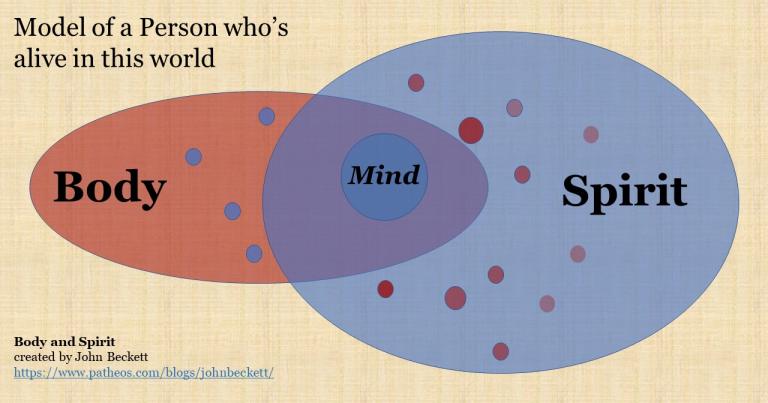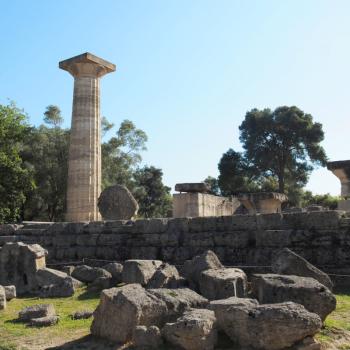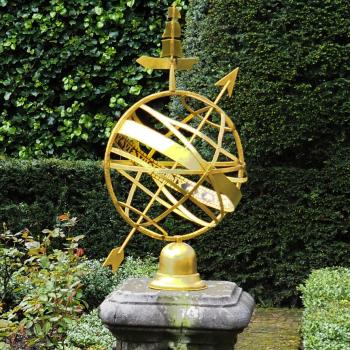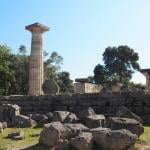In last week’s review of Mat Auryn’s new book Psychic Witch I expressed my dissatisfaction with the common Pagan idea of a three-part soul. If I’m going to criticize that concept I owe it everyone – and to myself – to offer an alternative.
Different cultures and different religions have many different ideas about the composition of the soul. As with so much in the realm of metaphysics, we have thoughts and concepts and speculations but nothing even resembling proof. We have no way of knowing who’s right, or even who’s less wrong. Some people believe that makes these questions meaningless, but I can’t help wondering about who we are and what we are at the most basic level.
These are my ideas and my thinking behind them. They are – I think – reasonable ideas, but they are grounded in an animist and polytheist worldview, not a materialist worldview. If you have different thoughts please share them in the comments. This post is intended to begin a conversation, not to establish dogmatic beliefs.
The three-part model is popular because it’s useful
The three-part soul is generally described as the Lower Self (the animal soul and the unconscious mind), the Middle Self (the conscious mind), and the Higher Self (the spirit, the God-soul). One of the reasons it’s popular is that it’s familiar – it’s similar to Freud’s idea that the personality consists of the id, the ego, and the superego.
From a slightly different perspective, the Lower Self represents our evolutionary impulses: the physical and emotional urges we don’t think about because they’re part of what kept our pre-human, pre-primate, and in some cases, pre-mammal ancestors alive long enough to pass their genes down to the next generation. The Higher Self represents rational thinking and the kind of empathy we share with animals that are most like us. The Middle Self tries to navigate between these “higher” and “lower” motivations to live a life that satisfies all of them, more or less.
The three-part model helps us understand why we have internal conflicts and why we often have difficulty doing things we know are beneficial and not doing things we know are harmful. Perhaps most importantly, it removes the unhealthy stigma of labeling natural urges “sinful.”
The three-part model is useful, so it’s no wonder it’s popular.
The shortcomings of the three-part model
Psychology is not religion and religion is not psychology.
In 2005 sociologists Christian Smith and Melinda Lundquist Denton came up with the term “moralistic therapeutic deism” to describe what they found to be the common beliefs among American teenagers. They outlined five key beliefs, most importantly the belief that “the central goal of life is to be happy and to feel good about oneself.”
Here in 2020 moralistic therapeutic deism is the de facto religion of many people in the West, not just teenagers. It is in part a reaction against the strict guilt-based approach of fundamentalists and other conservative religions, but it also represents a failure on the part of Mainline Protestants and other religious liberals to articulate a robust religious alternative to fundamentalism. Instead of religion they preach psychology.
Pagan and magical traditions have been doing this since the early 20th century. Freud and Jung were the hot topics of their day – Pagans of that era appropriated (and in some cases, misappropriated) their concepts much like contemporary Pagans do with quantum physics.
Psychology does a great job of explaining why we behave the way we behave. It does a completely inadequate job of explaining who and what we are at our core.
What even is a soul, anyway?
And what’s the difference between “spirit” and “soul”?
There are no universal definitions. A quick survey of Christian sources show multiple vague opinions, but most associate “spirit” with the immortal essence and “soul” with what gives life to the body. Many Pagans adopt this thinking (if they give it any thought at all), which is another reason the psychology-rooted three-part model of the soul is attractive.
And yet in our rituals, we often speak of the souls of the dead. We say the Egyptian ba and ka are two parts of the soul. What is it that produces past life memories? How are near death experiences – especially accounts of people who watched their own surgery from above – possible? What does after-death communication connect us with? My answer to all these questions is “the soul” – the part of us that survives death.
I have a very difficult time differentiating between “soul” and “spirit” – I tend to think they’re two words for the same thing.
In any case, I want to avoid an appeal to etymology and argument from the dictionary. Instead, I want to outline a different model of who and what we are, and then we can figure out what words to associate with it.
The soul as “what gives life to the body” is unnecessary
Genesis 2:7 says “And the Lord God formed man of the dust of the ground, and breathed into his nostrils the breath of life; and man became a living soul.”
I don’t normally quote the Bible, but this concept is not unique to the Abrahamic traditions and it’s quite common in our society. I think this concept is unhelpful because the body needs nothing to give it life. We are born alive and we remain alive until our body dies.
Also, we sometimes speak of very evil people as “soulless” – and yet they’re very much alive. Whether they really are soulless is another question, but it demonstrates again that biological life does not depend on non-biological elements for continuation.
You are a spirit
In some of the recent conversations on animism, I repeated the idea that instead of saying everything has a spirit, it would be better to say that everything is a spirit and some spirits have bodies.
You are a spirit, your cat is a spirit, the tree in your back yard is a spirit. And here I define “spirit” as the eternal, non-material essence of a person – whether that person is a cat, a tree, a planet, a human, or a God.
Where do spirits come from? I don’t know, but we don’t have to answer that question to recognize that spirits do exist… even though I’m extremely curious about their source.
You have a body
At this moment, you and I are embodied spirits. Our eternal essence is infused into a living organism and it resides there for the duration of this life. Most of the time, anyway – astral projection and out of body experiences are two exceptions.
The body is more than a container. A glass holds water and gives it shape and form, but remains separate from it. The body is more like a wooden whiskey barrel. It holds the whiskey – also called “spirits” – but because it’s porous the liquid moves into and out of the wood. Over time this transforms the clear distilled alcohol into a rich brown whiskey with a variety of complex flavors. What kind of flavors you get depends on the ingredients in the distilled whiskey, but also on the kind of wood used to age it, and what – if anything – was stored in the barrel before. Bourbon is stored in new oak barrels, while Scotch is typically stored in barrels that previously held bourbon.

We are much the same. Our spirit takes on some of the characteristics of our body, and our body takes on some of the characteristics of our spirit. You are more than your body, but your body impacts your life, your experiences, and your interpretations of those experiences. Over time those experiences and interpretations become part of who and what you are, not just in this life but forever.
All the “animal nature” elements the three-part model puts in the Lower Self are part of the body. There is value in recognizing that some of those elements are hidden from our waking thoughts, but that doesn’t mean they have a different source. They’re all part of the body.
Consciousness and rational thought
The mind is more than brain activity. The more I read and the more I contemplate, the more I’m convinced that it is consciousness, not matter, that is fundamental to the universe. The next questions, then, are “what is consciousness?” and “is consciousness a part of the spirit?”
I don’t have solid answers to those questions – they’re beyond our current knowledge. My provisional answer is that consciousness is a part of the spirit. But all interactions with spirits – including our own spirits – are necessarily filtered through our bodies.
The three-part soul model says the Middle Self is the conscious mind, which tries to balance the wants and needs of the Upper and Lower Selves. I see what we call the Middle Self as the interaction of the body and the spirit. If it is a separate thing – and I tend to think it is not – it proceeds from the body and the spirit. It is not a “third element” of who and what we are.
I spend a lot of time trying to think rationally. As tempting as it is to conceive of rational thought as its own unique thing, and as much as our mainstream culture speaks of a three-part “body, mind, and spirit” I can’t find a place for rational thought as anything other than the intersection of the body and the spirit.
Avoiding dualism
Dualism is the idea that the mind and the body are separate, usually with the presumption that the mind is superior. It’s the source of (or perhaps, the product of) the Christian idea that the physical world is “fallen” and that our “true home” is in another place in another life.
Modern Paganism rejects dualism. It says that the world is not fallen and the pleasures of this life are necessary, good, and even holy.
Accepting a body-spirit model does not require a return to dualism. It requires us to move beyond the useful-but-limited whiskey barrel metaphor and recognize that while we are alive in this world, our body and our spirit are a fully blended solution that requires extraordinary operations to split, not a suspension that will naturally settle and separate.
What lives on after death?
Who we are in life is the interaction of our body and our spirit, impacted and influenced by our environment and our experiences. But what happens when we die?
The one thing we can say with certainty is that the body ceases to function – and the brain is a part of the body. In 2017 I wrote One Pagan’s Thoughts on What Comes After Death that details what I expect to experience after I die and why. I’m not going to repeat that here, except to point out that I kept saying “I expect.” That presumes the essence of who and what we are lives on after death.
What lives on is the spirit. And while the spirit may be eternal, it is not unchanging. Going back to the whiskey metaphor, the liquid that comes out of the barrel retains some of the characteristics of the barrel, even as it loses the shape and form the barrel provided.
A picture worth many words
Philosophers have been debating the nature of the soul for thousands of years, and some of them have developed sophisticated models that are far deeper than can be expressed in a blog post by someone whose primary calling is to be a priest, not a philosopher. My goal here is to express why I disagree with the three-part model of the soul, and – however imperfectly – to articulate a different model.
And so I leave you with this diagram, because sometimes pictures can communicate what words cannot.
I’m catching some early flak on Facebook from people who are saying “some traditions have a three-part model of the soul that aren’t based in Freudian psychology.” Of course this is true. I thought the second paragraph of this post was enough context for the argument I’m trying to make – namely, religion isn’t psychology and psychology isn’t religion. Clearly I wasn’t explicit enough.
There are cultures and traditions both ancient and modern who have three-part models of the soul that are substantially different from the model common in Pagan and New Age circles that I argue against here. I have no issues with those models, and I encourage those who find wisdom in a non-Freudian three-part model to articulate them here, or to direct me and other readers to sources on them.
This post is intended to begin a conversation, not to establish dogmatic beliefs.





















